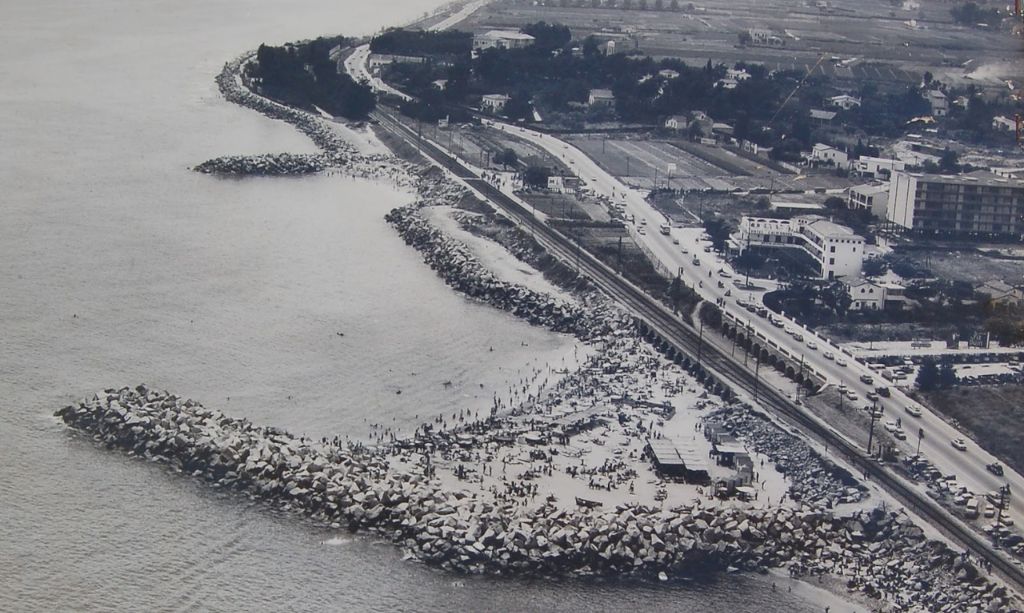A stroll through the past of Les 3 viles
We suggest a route of discovery along the seafront of Les 3 viles. A journey into the past as you tackle fifteen challenges you will find along the way.
Go to the Tourist Information Points or the Tourist Offices with your family and friends to pick up a small booklet that will be help you work out the fifteen challenges and decipher the Final Puzzle. Once completed, you can pick up a gift at the Caldes d’Estrac Tourist Office or at the Balís Port Office.
A 4 km route on foot awaits you. If you take your time, you’ll need about two days to complete the whole game, but you can also do it quickly in one morning. If you prefer a bicycle or scooter, you’ll have finished in one day.
The printed game is available in Catalan, Spanish and English.

DOWNLOAD THE BOOKLET
ENG
CAT
ESP
FRA

For the curious
If you want to know more about the stories behind each of the fifteen landmarks of the Stroll through the Past of Les 3 Viles, you can discover some interesting facts here.
Caldes d'Estrac
1 - Palau Foundation
Josep Palau i Fabre, born in 1917, was a poet, playwright, storyteller, essayist and a great scholar of painting, especially the work of Pablo Picasso. Through his relationship with key figures such as Picasso and the writers Antonin Artaud, Octavio Paz, Federico García Lorca and Rafael Alberti, among others, he linked Catalan culture with the most important artistic currents of the 20th century.
An interesting aspect is that, when Picasso died, his wife Jacqueline did not allow Palau to attend the artist’s funeral. Palau was photographed leaning against one of the walls of the estate where the funeral was being held, after he was refused entry. He was not the only one to be rejected, as Jacqueline also threw the wreath Dalí had sent out the window and also refused to allow one of Picasso’s children to attend.
![1 palau – picasso – Picasso amb Josep Palau i Fabre i Bill Hartmann [document gràfic bidimensional]. Fotògraf_ Lucien Clergue. Mougins, 31.05.1968. b_n. 100×150 mm. Fundació Palau](https://visitles3viles.cat/wp-content/uploads/elementor/thumbs/1-palau-picasso-Picasso-amb-Josep-Palau-i-Fabre-i-Bill-Hartmann-document-grafic-bidimensional.-Fotograf_-Lucien-Clergue.-Mougins-31.05.1968.-b_n.-100x150-mm-1-qu1t10ylexnqn1rzhemjj5txzeo0hzvtlbhj8o82lm.jpg)
Picasso with Josep Palau i Fabre and Bill Hartmann.
Photographer Lucien Clergue. Mougins, 31.05.1968.
2 - Joan Maragall Park
The beaches, mountain and sea breeze of Les 3 viles were a source of inspiration for poets, painters, jewellers, writers, designers and others, who created unique pieces.
The Masriera family, summer holidaymakers and originally from Llavaneres, were a family of artists, jewellers, painters and designers who were well known for their work, particularly Lluís Masriera, one of the most outstanding representatives of jewellery, whose pieces are still made by hand.
Joan Maragall, a man of culture and letters and summer resident in Caldes, was one of the most influential artistic and literary figures of his time and is considered the great poet of the Catalan cultural movement known as Modernisme.
Less well known, Carme Martí Riera, resident in Sant Vicenç, was a very popular dressmaker and clothing designer who won numerous awards in international haute couture exhibitions. She created the Martí System of patternmaking that revolutionised the world of fashion, and is celebrated and studied worldwide.
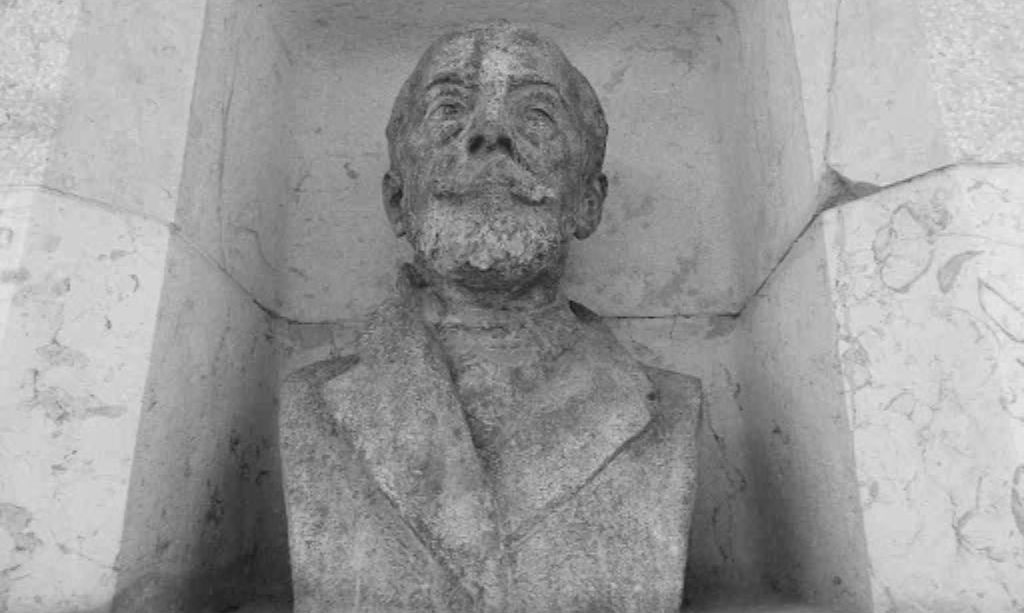
3 - Hotel Colón
Thermal waters are part of the character of Caldes d’Estrac, and water of 39 °C flows from a spring next to the stream, at the foot of the Estrac hill. The healing properties of water have been known since ancient times and are actually linked to the origin of the town (1219). From the 18th century, the spring reached its maximum splendour and was the beginning of El Colón, in the same place as the building today.
To adapt to new trends, El Colón became the “Casino Colón”, after refurbishment in 1918, and with the installation of roulette and gaming tables.
At its peak there was a direct train from Barcelona to Caldetes called “La Fletxa d’Or” (The Golden Arrow), so named because the casino players used to travel on it. This train ran until 1924, when the Primo de Rivera dictatorship banned gambling and closed casinos such as those in Caldes and La Rabassada.
Interestingly, during the Spanish Civil War (1936-1939) the Hotel Colón was first occupied by the Committee of the Spanish Republic and then became a popular Athenaeum.
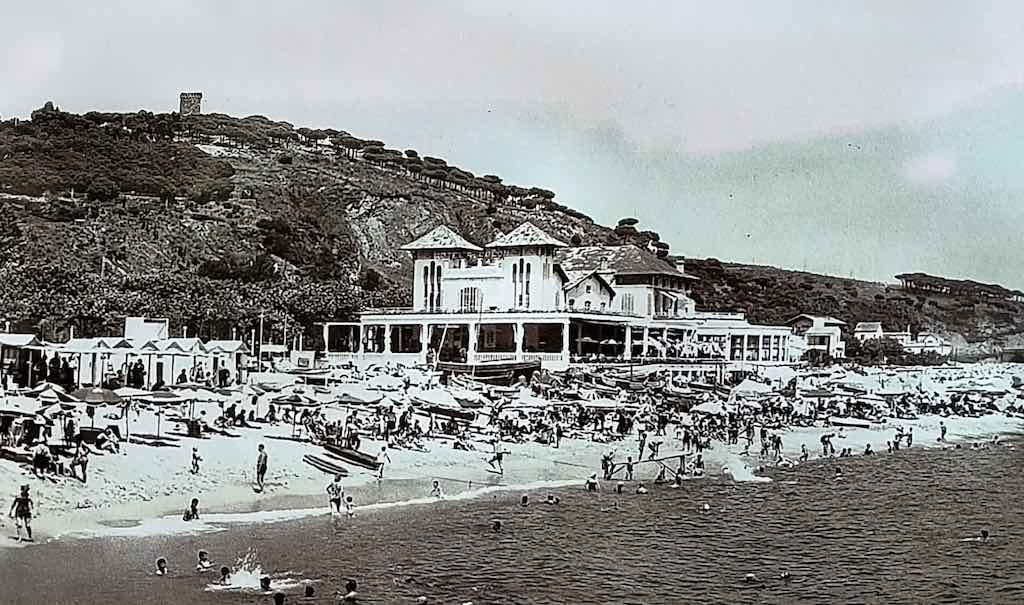
4 - Els Tres Micos (the three monkeys) beach
The Three Wise Monkeys is a tradition of Japanese origin that embodies the principle of “see no evil, hear no evil, speak no evil”.
Els tres micos was the name of a summer house located at 12, Passeig dels Anglesos, in Caldes d’Estrac. The façade of the house bore a panel of ceramic tiles depicting three monkeys. Underneath the tile, right next to the door, was a large window, where there was always a smiling old lady sitting in an armchair. It was Mrs. Soldevila, and both the townspeople and the holidaymakers greeted her when they passed. Her husband, Mr. Soldevila, went down every day to bathe at three o’clock in the afternoon, wearing his blue bathrobe.
The Soldevilas lived there for fifty years, and when they bought the house, “the three monkeys” were already there. The panel, which is on the floor of the promenade, is what gave its name to the beach and the tip of the breakwater located in front of the house called Punta dels tres micos.
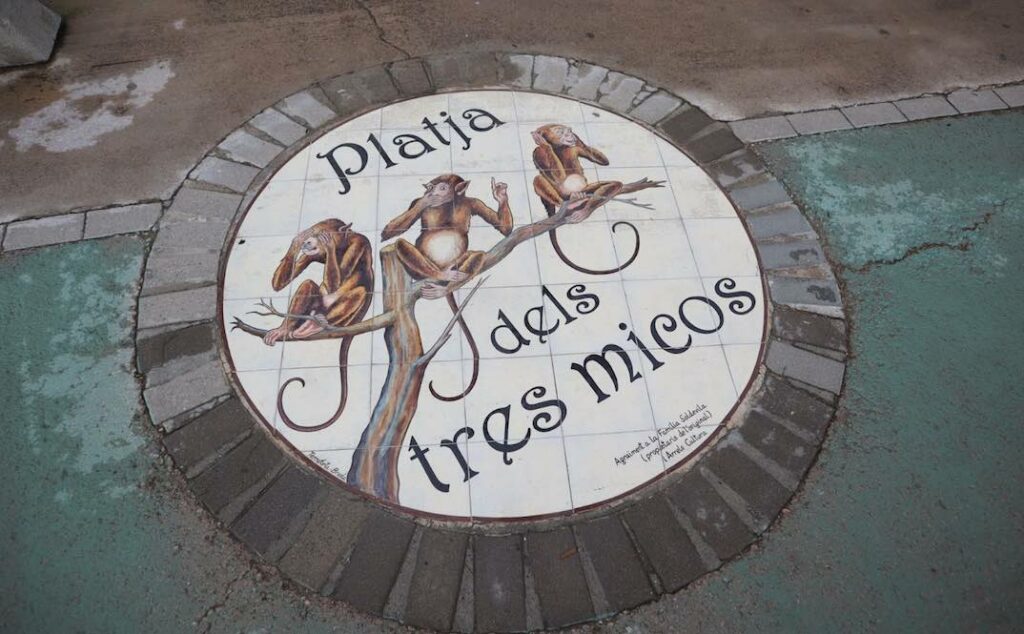
5 - Can Garriga, former British Consulate
It is the end of the Spanish Civil War (1936-1939) and, during the conflict, many of the holidaymakers’ houses were abandoned by their owners and occupied by various groups of the retreating Republic. When Barcelona began to be bombed by fascist planes (1938), the diplomatic delegations decided to settle in Caldes d’Estrac and retreat north. This town had previously been declared an open city, that is to say, exempt from bombing, and it was very easy for the respective navies to it supply by sea.
The British embassy was in Can Soler and the consulate in Can Mercè and Can Garriga, these last two houses were exactly the same.
The President of the Spanish Republic Manuel Azaña and his entourage of 35 people stayed at Villa Blanca located at 37, Passeig dels Pins, and at Can Ripoll, at 18, Passeig dels Pins, during the war. Manuel Irujo, Minister of Justice, and José Antonio de Aguirre, then President of the Basque government, spent some time in Can Marinel·lo, a house located at 12, Passeig del Marquès de Casa Riera. This villa was also called Can Garí or Can Freixes.
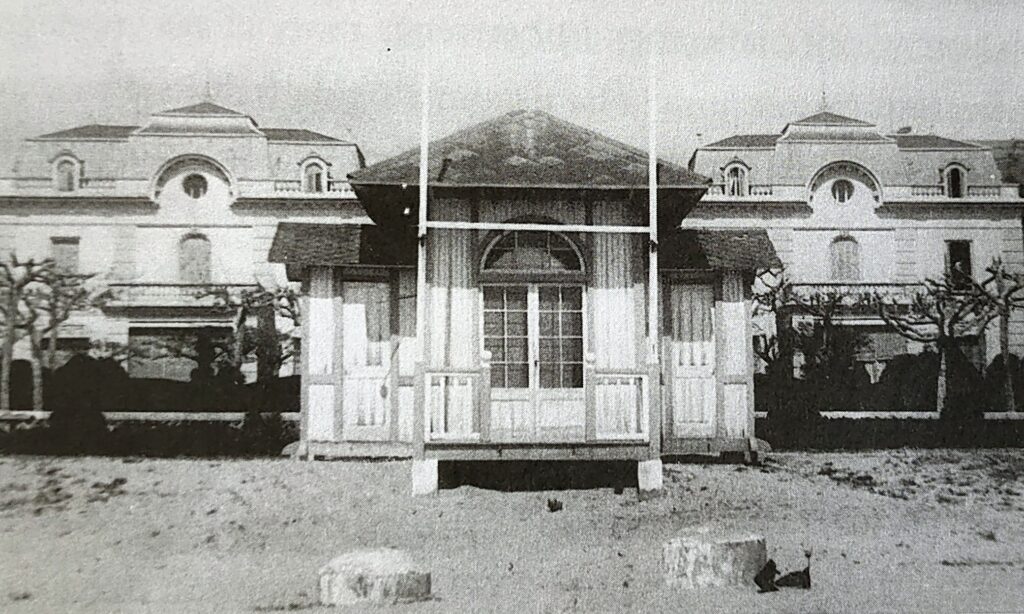
Sant Vincenç de Montalt
The sign indicating Passeig del Marquès de Casa Riera marks the end of the town of Caldes d’Estrac and the beginning of Sant Vicenç de Montalt.
The saint that appears on the sign is Saint Vincent, which we know because he is carrying a palm as a representation of the defence of his faith, and a book, a symbol of the faith he never abandoned.
The summit of Montalt is the highest point in the town, at a height of about 596 m, and is located between El Corredor and El Montnegre massifs. From the top you can enjoy magnificent views of the region and the coast. On clear days you can even admire the city of Barcelona and the foothills of Montjuïc, along with El Corredor and El Montnegre mountain range.
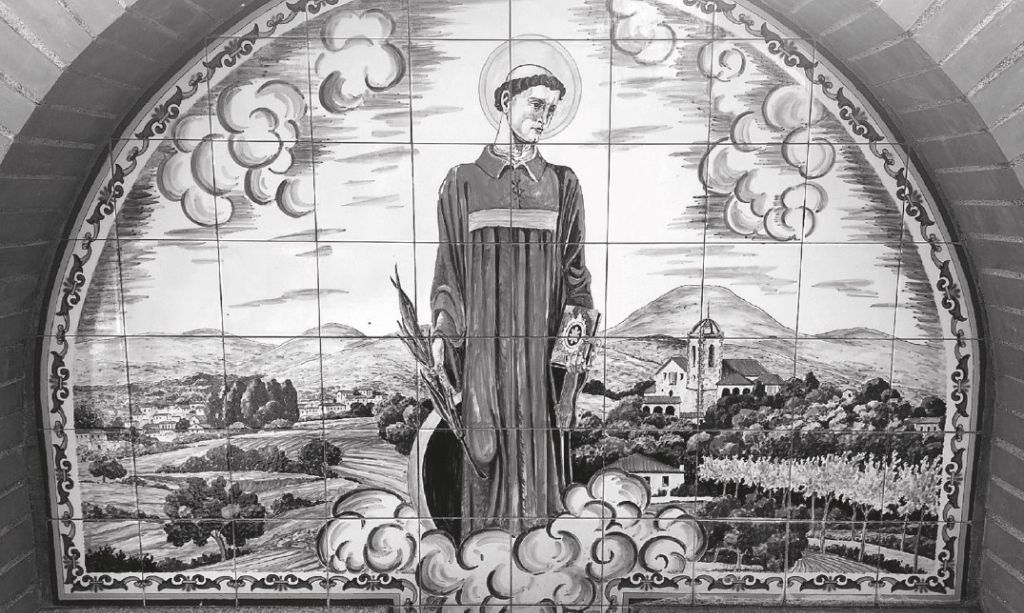
The Catalan art nouveau houses on the promenade are witness to a phenomenon of the 20th century called summer holidaying. It was a practice of the wealthy classes looking for moments of peace and enjoyment by the sea. Many seaside towns in the Maresme region began to welcome these families seeking quiet, healthy air and thermal waters, fleeing a Barcelona full of factories and noise.
The existence of summer resorts encouraged the construction of buildings by renowned architects beyond Barcelona and, with it, the introduction of certain architectural currents in the coastal and mountain towns, from eclecticism from the end of the 19th century to the avant-garde rationalism of the 1930s, as well as Modernisme and Noucentisme.
The summer towns that proliferated most and became famous were those located close to Barcelona, which enjoyed thermal waters and were reached by train. For these reasons, Les 3 viles were chosen destinations, which grew and prospered considerably at this time.
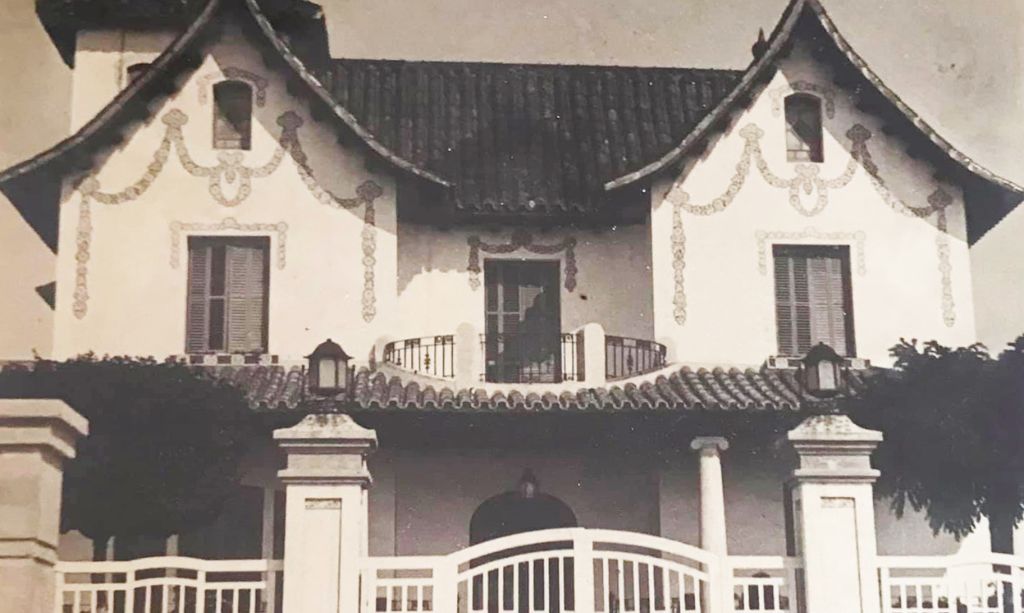
The Casa Sans, pg. Marquès de Casa Riera, 7/8, “casa de les Punxes”
The Can Valls Watchtower is located in the Germans Gabrielistes Park, a large space full of gardens of almost 4 hectares. You will be able to discover native flora of the area and centuries-old trees of great beauty.
During the 16th and 17th centuries, these types of towers acted as a defence against the pirates and privateers of the Mediterranean, although in later centuries they were destroyed by the monarchs in order to prevent them from being used against them and their interests. These lookout points offered a better view of the sea and the arrival of ships.
Do you know the difference between privateers and pirates?
The pirate was an outlaw and robbed others for his own profit. The privateer, on the other hand, was supported by a nation or government and attacked ships of rival countries in search of treasure.
The coast of the Maresme region suffered many attacks of piracy and privateering, which explains the 55 towers all along it.
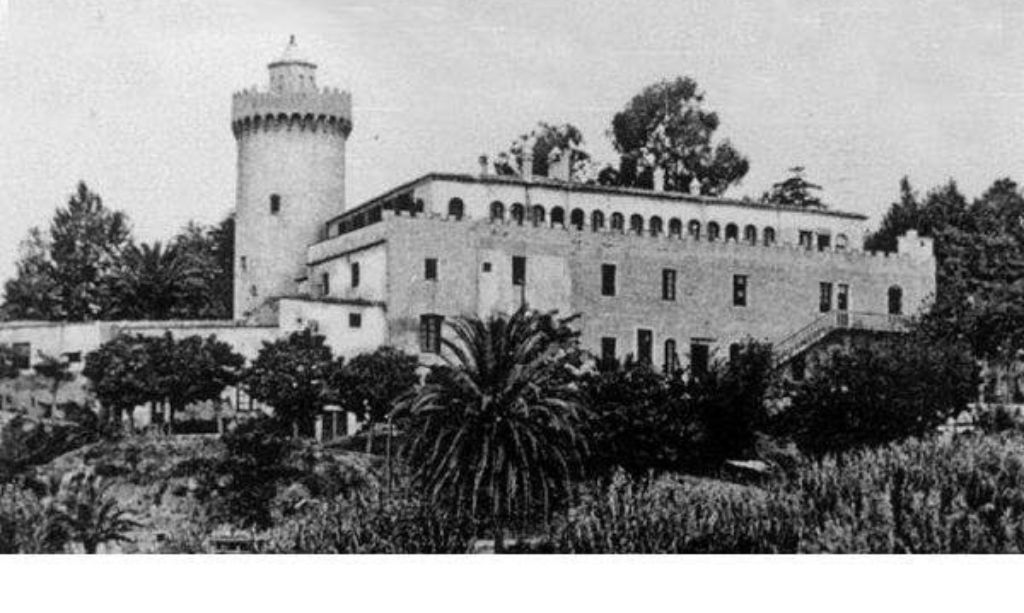
Manuel Deschamps was captain of the ship called El Català, which set sail on its way to Cuba. The captain was considered a hero during the war, as he was able to supply the island of Cuba with food and soldiers, bypassing the naval blockade of American ships three times during the conflict with the United States for the independence of Cuba (1898).
El Català was never sunk during the Cuban conflict and returned intact. Later, the ship participated by transporting cargo and troops in the First World War (1914-1918), leased by the French government.
The story is well known. The most famous havanera song is about this ship and the men it carried: “El meu avi” (My grandfather). You may know it, here’s a fragment.
My grandfather went to Cuba
on board El Català,
the best warship
of the overseas fleet.
The helmsman and boatswain
and fourteen sailors
were born in Calella
were born in Palafrugell.
When El Català set out to sea
the boys from Calella used to prepare a mulled wine,
and hands on the guitar used to sing:
Long live Catalonia! Long live El Català!
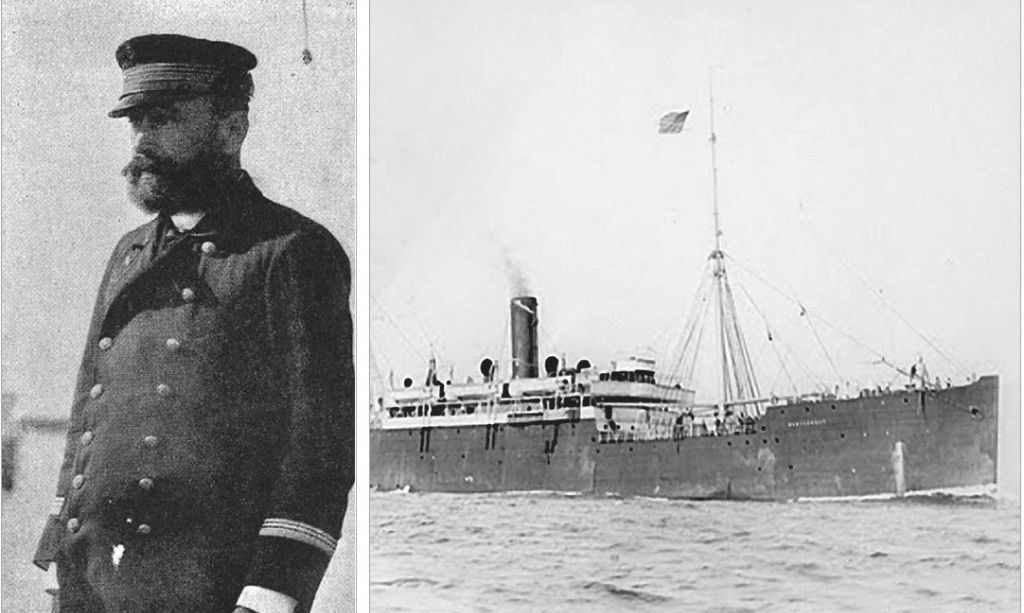
Do you think palm trees are typical of and indigenous to the area? In fact, these come from far away and were brought by the indianos who returned from the Americas, which had been their home for so long, and wanted to recreate the spaces where they lived before and decorate them in the same way, with colourful houses and typical vegetation, especially palm trees.
Every time you see palm trees in front of a stately home, it is a probably an indiano house. This is not only seen on the shores of the Maresme region, but extends along the Catalan coast and includes towns with an indiano past. This can also be seen on the northern coast of Spain with the stately houses of indianos who returned following the independence of the colonies.
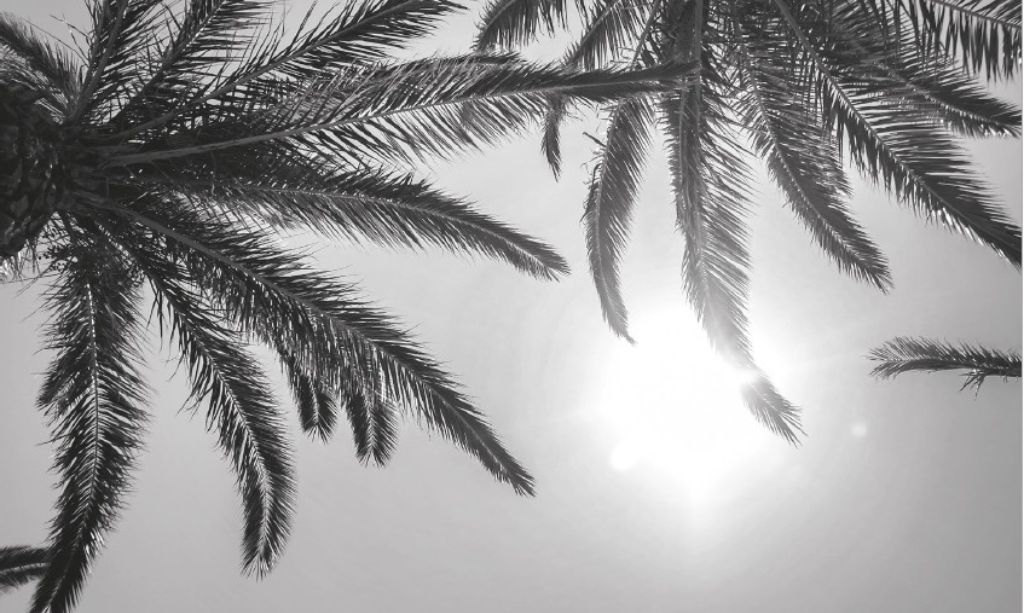
Sant Andreu de Llavaneres
Balís Port, created in 1966, is a benchmark for leisure and nautical sports in Catalonia.
The marina grew from an initial building to the architectural complex it is today. As you can see, sailing is the main activity.
The construction of the marina added more than 400 berths for ships, which made the marina better and more attractive to future partners. After the improvement works, they grew from 60 members to over 300.
Finally, in the 1980s, the Sports Commission of El Balís was established, bringing the club unstoppable growth, reflected by great yachtsmen, some of them Olympians, and the prestigious competitions held.
Under the motto “We sail for the environment”, the club made a series of modifications in order to reduce and improve waste collection to make its members aware of the importance of protecting nature and the environment.
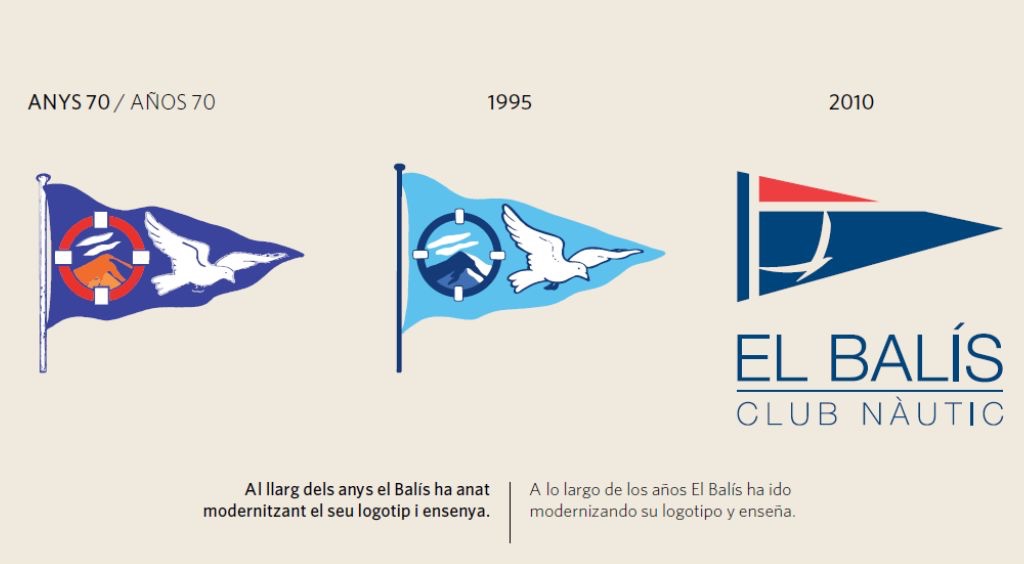
Did you know that in the past the beaches you see now were full of boats? This can be explained by the town’s not-so-old fishing past. As a maritime town, fishing was a very important activity, and the fishermen and their families lived by the sea and there were not yet such large and luxurious houses on the seafront. These were built later and are directly related to the indianos and the summer houses.
Les Barques beach is so called because it reflects the town’s fishing and maritime tradition. We can often learn about the most authentic past of the town through the place names.
As a point of interest, did you know that one of the hypotheses for the origin of the town’s name is the “Serena Vall”, which read backwards, is Llavaneres. They say it got this name from the first settlers because of its location in a valley between two mountains.
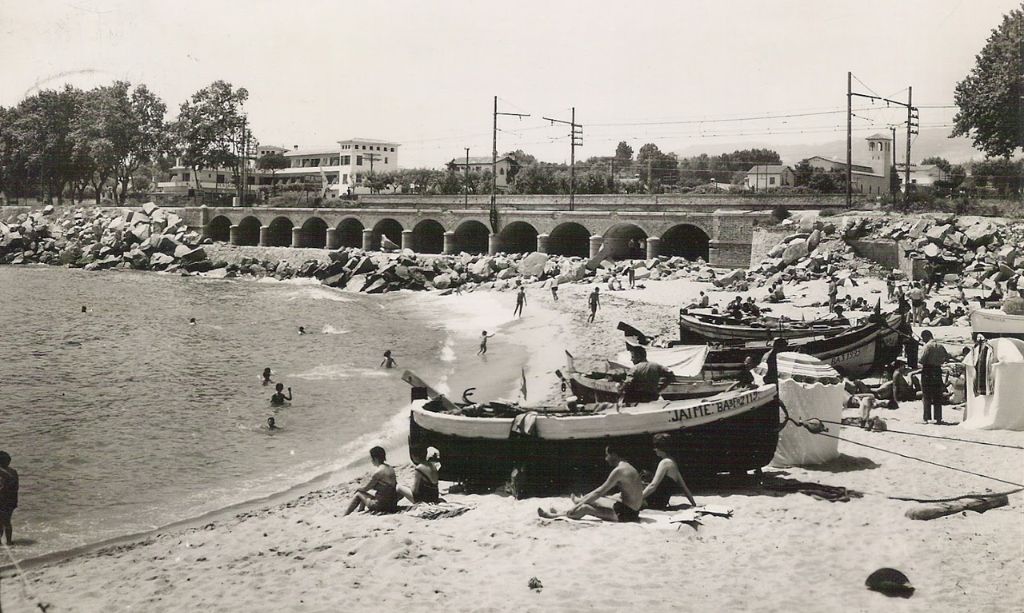
The first train section of the Iberian Peninsula ran from Barcelona to Mataró. On 5 October 1848, a first trial was carried out and, three days later, 400 people travelled on it.
In 1900, Llavaneres was opened as a drop-off station, although the train arrived in the town in 1857, when the section from Mataró to Arenys de Mar was opened. The arrival of the train was essential for the economic development of the area and made it possible to experience the golden age of summer holidays for wealthy residents of Barcelona who mainly came to rest and recharge their batteries with the sea, sun, fresh air and mountain.
This photograph shows the initial Sant Andreu station. The building is no longer there, but the location is the same. Imagine arriving at the summer town on a steam train without any motorway or major road nearby. It would have been a magical experience travelling and observing the coast and the coastal towns of the Maresme.
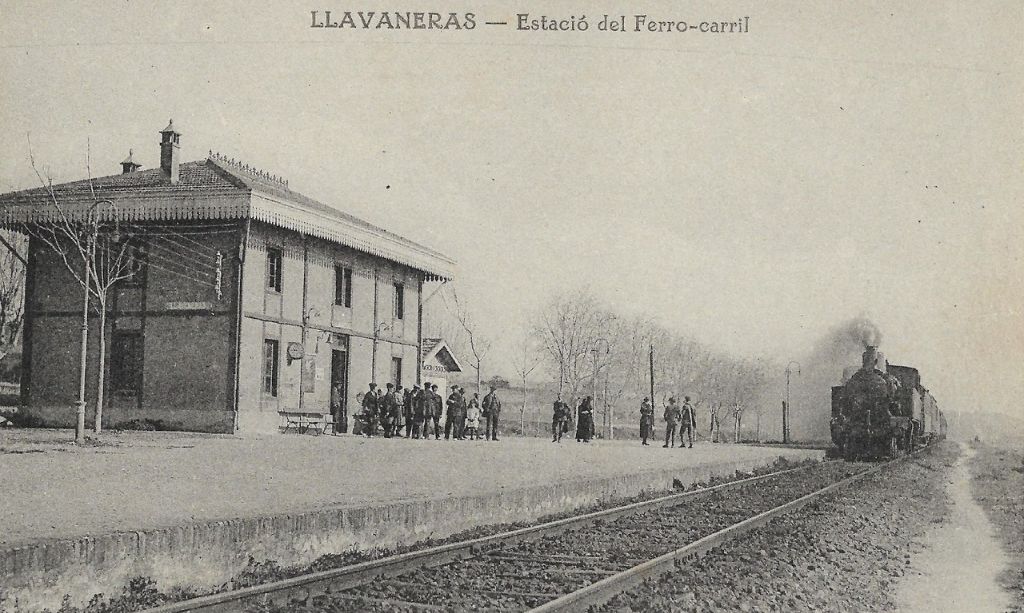
Along the promenade in Llavaneres there is a white circular balcony that was the home of the textile industrialists Solà-Sert. On the left, looking towards Mataró, you will be able to see what was a coastal defence point during the Spanish Civil War (1936-1939), a type of construction present throughout the Catalan coast. Their purpose was to defend the coast from enemy planes and ships, and they were located in strategic points with great visibility and easy to camouflage.
Inside this construction, called a machine gun nest, was a machine gun anchored with a round base. The nest is this shape as it seeks to offer protection from the enemy and not to be seen by attackers, thus blending in with the surroundings.
Anti-aircraft batteries also extend along the coast and have the same function. This is a set of covered machine gun nests, either open like the one in Sant Pere Màrtir in Barcelona or closed, like the one in El Turó de la Rovira.
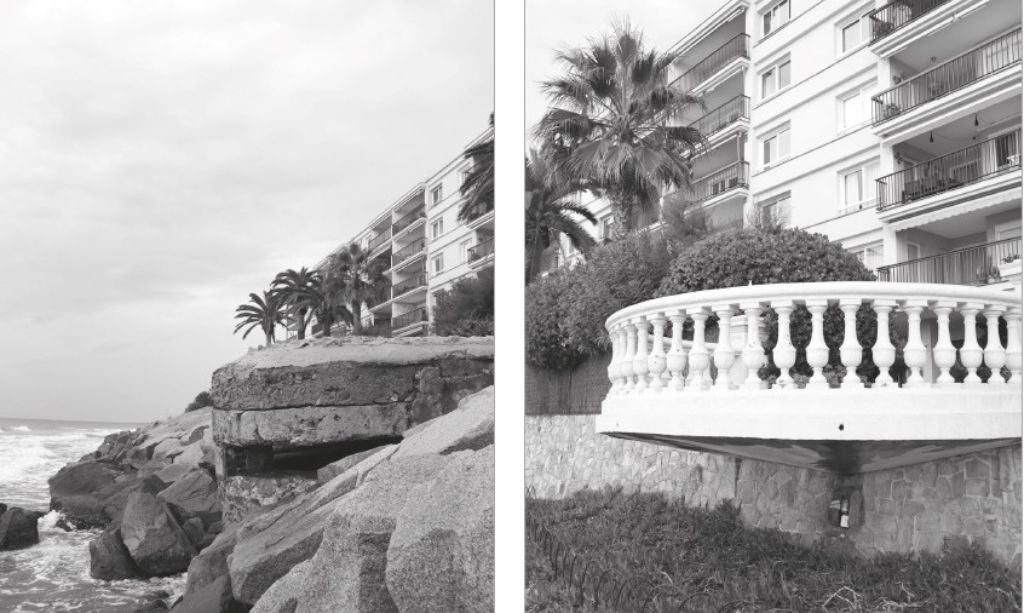
From this point you can enjoy a magnificent view of the Mediterranean Sea and the Maresme beaches. If you look closely, you can see the silhouette of the tallest buildings in Mataró, and, weather permitting, some parts of Barcelona.
In the past, in the farmlands of Les 3 viles, carnations were planted in the fields. At present, on the flatter land by the sea, we can still find some fields dedicated to floriculture and the cultivation of the renowned Llavaneres pea.
The Llavaneres pea, distinguished with a quality seal, is grown exclusively in the farmlands of the Sant Andreu de Llavaneres. This pea was first recorded from the 17th century, with documented references in the Diario de los viajes y hechos en Cataluña. Production remained vigorous throughout the 1930s and it was exported to France. The main characteristic of this pea is its sweetness, and it is grown in siliceous and sandy soils. The harvest, which starts around March, can last one or two months.
As you can see in the photograph, there used to be a breakwater. This stone massif that stretched across the sea protected what would be the new Balís Port from the waves. This breakwater no longer exists, but there are many photographs that show how the coastline of Les 3 viles has varied over the years.
